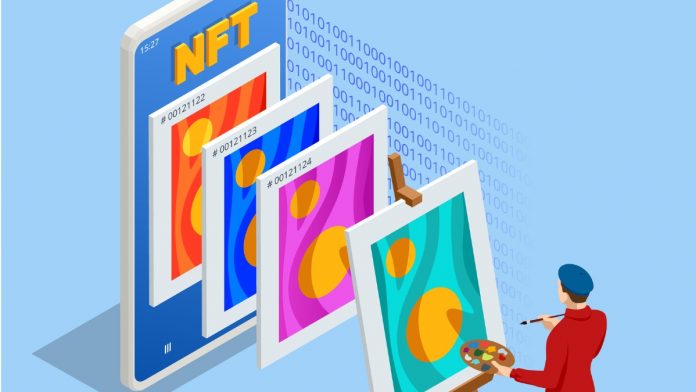Ownership Rights
The idea behind NFTs is excellent. Blockchain is meant to empower artists and give them even more control over their work. It’s supposed to protect them from theft – digital artists in particular. It’s far from the most practical potential uses of this tech, but it’s one that came up, so that makes NFTs one flagship for other use cases.
All the popular NFT platforms today technically don’t sell artwork. What they sell is a link leading to it. Blockchain doesn’t store the entirety of the work, though suggestions were raised to incorporate compressed versions somehow. Unfortunately, that is not the case yet.
So, NFT collectors are buying links that, in a few decades, no one will be able to verify whether they lead to the original artwork. How could anyone verify ownership with certainty if the NFT platform startup simply fails?
There is another problem plaguing the NFT platforms. Ironically, it is art theft – forgery.

Most of the artists on NFT platforms are unverified, enabling scammers to hide in the sea of anonymous users. There, they are free to download images sold on these platforms and upload them as their own – potentially even on the same platform.
For this and other reasons, here are a few things to keep in mind before investing in NFTs and adopting a whole NFT trading strategy.
Verification
Research projects yourself. Verified projects are, of course, more trustworthy. NFT’s Smart contract contains its transaction history, enabling you to track down the creator and owner of said NFT.
You can also do some investigating yourself by checking out social media and other NFT platforms to ensure that the project is valid. Keep in mind that there are several types of NFTs, and they come with a separate investment logic.
The Roadmap
The project roadmap and its strategic plan should make sense. It should document reasonable goals and feasible strategies, thereby signaling its long-term value as an investment. A project should have plans, at least for the near future.
The roadmap should be laid out clearly on the project’s website. Speaking of project websites – that one is a must. Considering how easy and accessible building a website is using, for example, website builders – any project that wants your money should woo you a little with an enticing website.
The rewards should not be unreasonable. You should not expect to have the opportunity to meet a Hollywood celebrity if you invest $100 in an NFT project.
What is the plan, and how will the project get you there? What are the marketing and growth plans? Don’t fall for just the virality element. More on that note later.
Too Good to be True
It happens all too often in the crypto space. People just jump on the hype train without researching and fall for the scams. Good old sound logic will serve you well even in this space. If it sounds too good to be true – it probably is.
If a project promises significant returns with little investment, you might want to stay clear. There are probably a hundred or a thousand who lost their money for one lucky person who made it through such get-rich-quick schemes.
In these cases, either the developers are naive or straight-up malicious. In any case, a high-risk – high reward strategy should by no means inform the bulk of your investing.
Pump And Dump
Speaking of malicious developers, here is a trendy scheme: an NFT project asking people to pump money into it with no promised return on investment. The real goal is simple – get the investment money into the artist’s pocket. It’s the NFT equivalent of some meme-coins.
One primary indicator that a project is a pump and dump scam is that all the developers are insistent on anonymity. Although crypto has become synonymous with anonymity, keep in mind that making your project visible can be difficult without a human face behind it. All in all, making sense of projects can be a matter of an educated guess, so it’s no surprise that traders are starting to leverage data integration tools to help them keep the big picture in view.
Phishing Scams
To start trading NFTs, you will need to establish a wallet that trades Ethereum. Beware of anyone asking you for your 12-word seed phrase. Entering a project’s website or Discord server might put you on scammers’ radar. You might be targeted via credible-looking bots and prompted to provide your 12-word seed phrase for security or other reasons.
While you can (and should) simply not give it to them, the easiest thing would be to simply stay away from all the shady activity. This is not the only phishing method, and these people will not calm down until they have the entirety of the value of your wallet, so just don’t paint a target on your own back. Prioritize your security, and don’t let curiosity get the better of you.
To Sum It Up
NFTs are as volatile an environment as crypto. In addition, they come with an added risk of forgeries, which is important to keep in mind and might not be something a newcomer or a fresh enthusiast expects in this space. So, keep your head on your shoulders and invest responsibly. Remember, as they say, all trading carries risk.
Credit: Source link






















 Bitcoin
Bitcoin  Ethereum
Ethereum  Tether
Tether  Solana
Solana  USDC
USDC  XRP
XRP  Lido Staked Ether
Lido Staked Ether  Dogecoin
Dogecoin  Toncoin
Toncoin  Cardano
Cardano  Shiba Inu
Shiba Inu  Avalanche
Avalanche  TRON
TRON  Polkadot
Polkadot  Wrapped Bitcoin
Wrapped Bitcoin  Bitcoin Cash
Bitcoin Cash  Chainlink
Chainlink  NEAR Protocol
NEAR Protocol  Polygon
Polygon  Internet Computer
Internet Computer  Litecoin
Litecoin  LEO Token
LEO Token  Uniswap
Uniswap  Dai
Dai  First Digital USD
First Digital USD  Aptos
Aptos  Ethereum Classic
Ethereum Classic  Hedera
Hedera  Cosmos Hub
Cosmos Hub  Cronos
Cronos  Stellar
Stellar  Filecoin
Filecoin  Stacks
Stacks  Mantle
Mantle  Render
Render  Immutable
Immutable  Optimism
Optimism  Pepe
Pepe  OKB
OKB  Renzo Restaked ETH
Renzo Restaked ETH  XT.com
XT.com  Arbitrum
Arbitrum  Sui
Sui  dogwifhat
dogwifhat  Bittensor
Bittensor  Wrapped eETH
Wrapped eETH  Maker
Maker 
